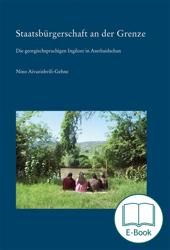The present book “Citizenship at the Border. The Georgian-speaking Ingiloys in Azerbaijan” ethnographically explores, on the one hand, the relationship between state and citizens in general and, on the other hand, the role of ethnicity and minority status of a particular (partly Christian, partly Muslim) group in Azerbaijan. The analysis focuses on questions of representation and ethnic leadership positions: Who speaks for the minority? By means of which legitimation strategies? And how do integration, participation, and citizenship in the Azerbaijani state play out?
The present book “Citizenship at the Border. The Georgian-speaking Ingiloys in Azerbaijan” ethnographically explores, on the one hand, the relationship between state and citizens in general and, on the other hand, the role of ethnicity and minority status of a particular (partly Christian partly Muslim) group in Azerbaijan. The analysis focuses on the question of representation and ethnic leadership positions: Who speaks for the minority? By means of which legitimation strategies?
The book analyses the structural integration of the Ingiloy minority, their participation in the social, political and economic everyday life of independent Azerbaijan and, above all, their rights as citizens. The author examines the integration process both “from above” and “from below”. The first perspective looks at the state (before and after independence) and its role in the integration process. It is about state strategies of steering this process and their social consequences. The second perspective looks at the position of the Ingiloy people in this process and examines their position and presence in the institutions through which they negotiate with the Azerbaijani state.
The study shows that the multiple facets of citizenship generate different discourses and spaces in which Ingiloys manoeuvre as a group and as individuals. Their actions result in diverse processes, transformations and modifications of existing relationships, as well as in histories that illustrate the changes in structures, from religious or linguistic affiliation to kinship relations or rituals. The history of the Ingiloy people is similar to that of many other former Soviet ethnic groups and thus also opens up a perspective on the Soviet past.
Interviews as well as observations in the field show that the identifications of the Ingiloys are complex and situation-dependent and that the meaning of different attributes varies in relation to time and space. Religion and language open up a field of identity within which the relationship of the individual to the group and thus the structure and characteristics of the group become clear. Religiosity represents an important element of Ingiloy identity and is related to nationality. In addition to Islam and language, the degree of religiosity can also be understood as an ethnic marker of the Ingiloy people in the context of contemporary Azerbaijan.


 Sample
Sample